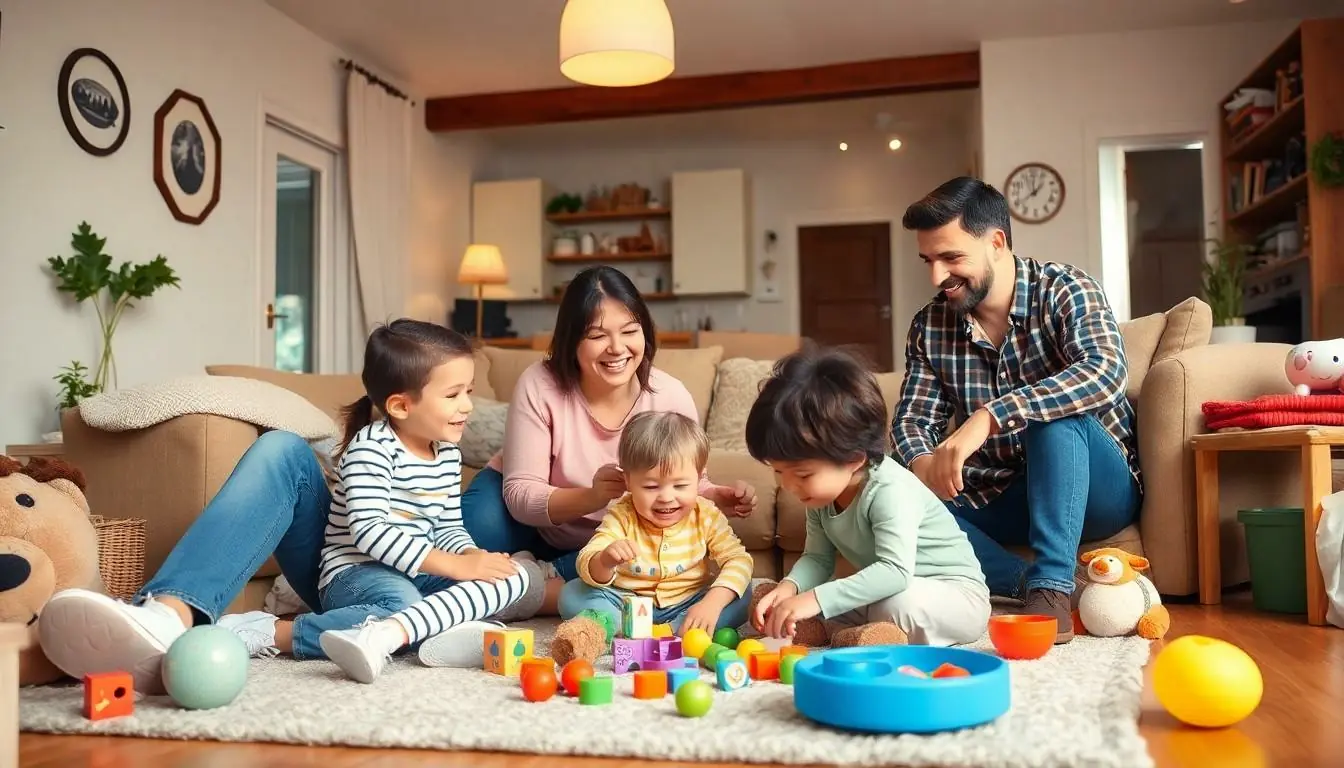Living together after a breakup might sound as appealing as getting a root canal while listening to elevator music. Yet more separated couples are choosing to co-parent under the same roof – a trend that’s redefining modern family dynamics.
This unconventional arrangement, often called “nesting” or “bird-nesting,” lets parents maintain stability for their children while navigating the choppy waters of separation. It’s like having your cake and eating it too – minus the romantic relationship but with all the parental perks. While it may raise eyebrows at PTA meetings, this setup can offer financial benefits and provide children with consistent access to both parents during challenging transitions.
Table of Contents
ToggleWhat Is Nesting Co-Parenting
Nesting co-parenting keeps children in the family home while separated parents take turns living there on a rotating schedule. During off-duty periods, parents stay in a separate shared apartment or their individual residences.
This arrangement focuses on minimizing disruption to children’s routines by:
- Maintaining their established school schedules
- Preserving existing friendships in the neighborhood
- Keeping their familiar bedroom environment
- Retaining access to regular activities clubs
The logistics of nesting typically involve:
- Creating detailed parenting schedules with clear transitions
- Establishing household maintenance responsibilities
- Setting up communication protocols for handoffs
- Managing shared expenses for both residences
Parents implement nesting through various scheduling options:
- Weekly rotations between the family home
- 2-3 day alternating schedules
- Extended periods matching school terms
- Custom arrangements based on work commitments
Common living arrangements include:
- Sharing a small apartment as the “off-duty” residence
- Maintaining separate individual apartments
- Staying with family members during off periods
- Renting short-term accommodations when away
The financial structure involves:
| Shared Expenses | Individual Expenses |
|---|---|
| Mortgage/Rent | Personal items |
| Utilities | Transportation |
| Groceries | Entertainment |
| Child-related | Secondary housing |
This arrangement provides stability for children while offering both parents consistent involvement in their daily lives. The focus remains on creating a smooth transition that prioritizes the children’s wellbeing during separation.
Benefits of Co-Parenting Under One Roof
Co-parenting in the same house offers significant advantages for both parents and children during separation. This arrangement creates a supportive environment that prioritizes family stability while managing the practical aspects of separation.
Financial Advantages
Living under one roof reduces the financial strain of separation through shared expenses. Parents save money on duplicate household items, utilities, maintenance costs and childcare expenses. A shared living arrangement eliminates the need for two full-sized homes, allowing families to maintain their current standard of living with reduced costs. The consolidated housing expenses enable parents to:
- Preserve financial resources for children’s education funds
- Split utility bills, property taxes and insurance premiums
- Share grocery costs and household supplies
- Maintain one set of furniture and appliances
- Pool resources for home repairs and maintenance
- Reduce transportation costs between homes
Emotional Stability for Children
- Lower levels of anxiety and depression
- Stronger academic performance
- Better social relationships with peers
- Continued bonds with extended family members
- Fewer behavioral problems at home and school
- Greater sense of security in their daily lives
- Stable sleeping patterns and eating habits
- Consistent access to both parents for guidance and support
Setting Clear Boundaries and Ground Rules
Successful co-parenting in the same house requires establishing explicit boundaries and specific guidelines. Clear rules create structure maintain privacy and foster respect between separated parents sharing living spaces.
Personal Space Guidelines
Private spaces serve as sanctuaries for each parent’s individual time. Each parent maintains exclusive access to their bedroom during their assigned residence periods. Personal items stay in designated areas like separate closets drawers or storage bins. Parents respect closed doors as signals for privacy and avoid entering each other’s spaces without permission. Digital boundaries extend to personal devices passwords and social media accounts remaining strictly separate. Individual schedules for bathroom usage gym equipment or home office spaces minimize conflict through clear time blocks.
Shared Space Management
Common areas follow structured usage guidelines to maintain harmony. The kitchen operates on alternating meal prep schedules with designated cabinet storage for each parent. Living rooms bathrooms and outdoor spaces remain neutral zones with equal access during shared time slots. Parents maintain a digital calendar for scheduling laundry facility usage entertainment system access and guest visits. Cleaning responsibilities rotate weekly with specific tasks assigned to each parent. A shared expense tracking system monitors household supplies utilities and maintenance costs. Child-related items stay in communal spaces allowing consistent access for both parents during their parenting time.
Creating a Successful Communication System
Effective communication forms the foundation of successful co-parenting in the same house. Establishing clear channels enhances coordination between parents while maintaining a stable environment for children.
Scheduling and Calendars
Digital calendars streamline coordination between co-parents sharing living spaces. Google Calendar or Apple Calendar apps enable parents to track custody schedules, children’s activities, doctor appointments, school events. A shared digital calendar displays color-coded entries for each parent’s responsibilities, household maintenance tasks, meal preparation duties. Parents update the calendar in real-time through mobile devices, ensuring both parties stay informed about schedule changes. Setting automated reminders 24 hours before transitions helps parents prepare for switches in residence time.
Decision-Making Protocols
Clear decision-making processes prevent conflicts in daily co-parenting situations. Parents implement a 24-hour response rule for non-emergency decisions via text or email communication. Emergency decisions regarding children’s health receive immediate attention through phone calls. A shared digital document outlines decision authority levels:
- Level 1: Individual parent decides (homework supervision, daily meals)
- Level 2: Joint discussion required (extracurricular activities, medical treatments)
- Level 3: Professional mediation needed (major educational choices, relocation)
Regular weekly check-ins occur Sunday evenings to address upcoming schedule changes, expense sharing, household maintenance. Parents document agreements in a shared notes app, creating accountability for follow-through on commitments.
Managing New Relationships While Co-Parenting
Introducing new romantic partners requires careful consideration when co-parenting in the same house. Parents establish specific guidelines for dating while maintaining respect for shared living spaces.
Dating protocols include:
- Meeting potential partners outside the family home
- Scheduling dates during non parenting time
- Avoiding overnight guests in the shared residence
- Maintaining privacy through separate communication channels
Partner introductions to children follow these timelines:
| Relationship Stage | Timeline |
|---|---|
| Casual Dating | No introductions |
| Serious Dating | After 6 months |
| Long Term | Gradual integration |
Each parent respects these boundaries:
- Keeping new relationships separate from co-parenting duties
- Discussing significant relationships before involving children
- Maintaining appropriate behavior in shared spaces
- Coordinating schedules to prevent overlap with new partners
Communication guidelines for new relationships:
- Informing the co-parent about serious relationships
- Discussing expectations for partner interactions with children
- Creating protocols for emergency contact situations
- Establishing boundaries for social media posts involving children
Both parents prioritize their children’s emotional wellbeing by:
- Monitoring children’s reactions to new relationships
- Maintaining consistent parenting routines
- Addressing children’s questions age appropriately
- Preserving family time without new partners present
These guidelines create structure while allowing both parents to pursue healthy relationships outside the co-parenting arrangement.
Common Challenges and Solutions
Co-parenting in the same house presents unique obstacles that require strategic solutions. Living together after separation creates specific challenges in financial management privacy boundaries that impact daily life.
Financial Responsibilities
Shared living expenses create complex financial dynamics between separated parents. Each parent contributes to mortgage payments utilities household maintenance based on predetermined agreements. A digital expense tracking system monitors shared costs like groceries childcare property taxes. Individual expenses such as personal items clothing entertainment remain separate. Joint bank accounts dedicated to household expenses streamline bill payments while maintaining financial boundaries. Monthly budget reviews ensure equitable distribution of costs prevent financial disputes. Some parents implement a percentage-based contribution system aligned with their income levels to maintain fairness.
Privacy Concerns
Personal space boundaries become essential when sharing living quarters after separation. Each parent maintains exclusive access to their bedroom during scheduled residence periods. Separate storage areas for personal belongings prevent unwanted overlap. Digital privacy measures include password-protected devices separate WiFi networks individual streaming accounts. Time blocks for common area usage minimize unexpected encounters. Sound barriers white noise machines enhance acoustic privacy between living spaces. Clear schedules for bathroom access laundry facilities reduce friction points. A shared calendar system helps coordinate space usage prevents scheduling conflicts. Installing locks on personal spaces provides additional security peace of mind.
Conclusion
Co-parenting in the same house offers a unique solution for separated couples who prioritize their children’s well-being. When executed thoughtfully with clear boundaries shared responsibilities and open communication this arrangement can provide stability and emotional security for children while maintaining financial efficiency.
Success in this unconventional living situation depends on both parents’ commitment to creating a respectful harmonious environment. By establishing comprehensive guidelines for shared spaces personal privacy and new relationships families can navigate this transition effectively.
While this arrangement isn’t suitable for every separated couple those who choose this path can create a supportive environment that puts their children’s needs first. With proper planning and dedication co-parenting under one roof can become a viable alternative to traditional separation arrangements.






